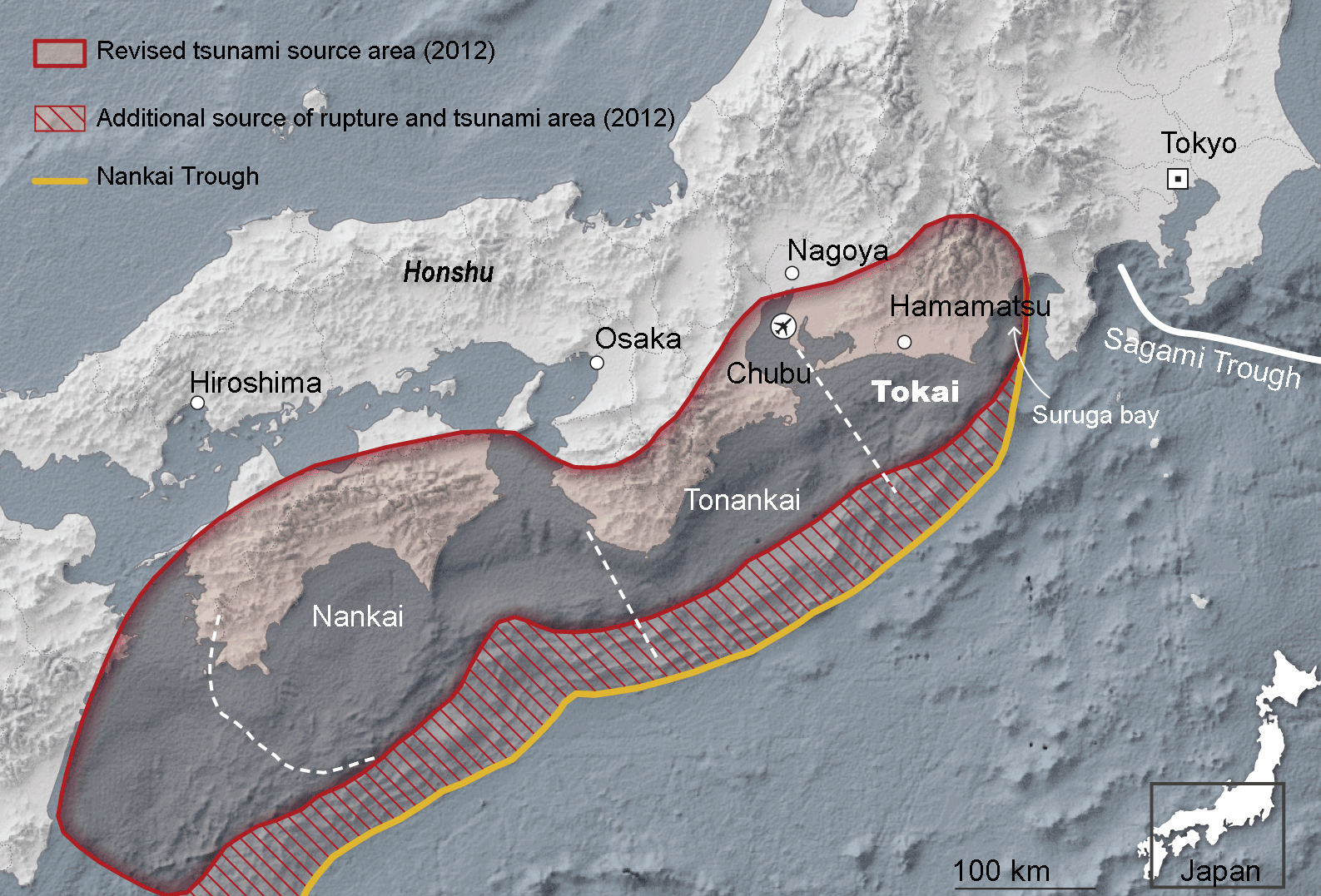Japan Tectonic Plates
A series of islands that together conform Japan, are the result of four tectonic plates that share this area. The North American, Pacific, Eurasian, and Philippine Sea plates intersect with each other all along Japan’s territory (Figure 1). The main island called Honshu, which is affected by the coalition of the North American and Eurasian plates. Meanwhile, in the Pacific Ocean the Nankai trough which starts in Miyasaki and ends in Shizouka, is the location where a future earthquake threatens to perform damage on Shikoku and Kyushu islands.

Nankai Trough
The Nankai trough located in the south east ocean of Japan is divided into three main sections, as Tokai, Tonankai, and Nankai (Figure 2). This trough has been hit by several earthquakes in the past and they have occurred after every 120 years approximately, plus it is a subduction zone capable of producing mega-thrust earthquakes.

In general, the records that we have about historical telluric movements in this trough, show that the three sections tend to coincide almost at the same time when one of them shake. However, the last record shows that the Tonankai section was hit by a (7.9 mag) earthquake on 1944, and two years later, the Nankai section followed with a (8.0 mag) earthquake, but the Tokai section was not ruptured by the last movements and it has been quite for 163 years (Figure 3)

Tokai Earthquake
As mentioned before, the Tokai section didn’t react concordantly with the other sections more than seventy years ago, and is has not been active in the last 162 years. According to the Geographical Survey Institute of Japan (GSI) that has been monitoring this area for the last 100 years, they conclude that “a steady strain accumulation has been happening in this region”, therefore the Tokai section is consider to have a potential Mw8 earthquake. In addition, due to the time gap or silence that this regular type of earthquake has, it could happen at any moment and is expected to occur when the subsidence stops, followed by an opposite upward movement.
Estimated Damage
The Shizuoka Prefecture in Japan which is an area that is going to be directly hit by the Tokai earthquake, has elaborated a document to register all possible damages and promote preparedness against this natural event.Also, is important to consider that Shizouka population according to the 1995 census was 3,737,360, and in 1998 this prefecture had 1,528,349 buildings.
- Physical Damage (Buildings)
In terms of architectural structures, the document portrays four categories of possible damage including; serious, moderate, slight, and flooding above floor level damage. As a conclusion, it’s estimated that around 800,000 buildings will receive one of the different types of damage listed before.
- Human damage
In this section, damage is distributed in three categories; death, severe injury, and moderate injury. According to the predictions, an average of 1,000 people will die, 2,700 will be severe injured, and 15,000 will suffer a moderate injury.
Earthquake Countermeasures
Therefore to protect lives and property, Japan has been investing in several projects like; communication facilities, tsunami prevention facilities, firefighting facilities, reconstruction of earthquake-resistant hospitals, schools and social welfare facilities, evacuation routes, and landslide countermeasures. The cost from 1979 to 2009 of these elements so far has been of 1,908 billion yen.
In addition to these measures, Japan Meteorological Agency has a guide to help predict the Tokai earthquake and contribute to lower the effects that this natural event will produce. This guide consists in three main different stages.
- Red alert
When the prime ministers issues a warning declaration due to a high risk regarding the Tokai earthquake. Later on, a response is given towards this declaration by the Establishment of Headquarters for Earthquake Disaster Prevention.
- Yellow alert
This second level alert happens when an observed phenomenon that could affect or promote the Tokai earthquake takes place. Then, there’s a response to the government and local-governments disaster management plans, followed by prevention measures.
- Blue alert
The blue alert takes place when any anomalous phenomena are observed. The distinction here is that there is no action required, except for information gathering.
